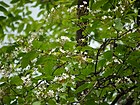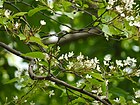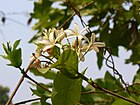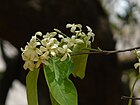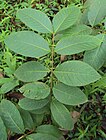Note: This is a project under development. The articles on this wiki are just being initiated and broadly incomplete. You can Help creating new pages.
Holarrhena pubescens - Indrayavah, Kutajah
Holarrhena pubescens is a deciduous shrub or tree with fragrant white flowers and abundant white latex in all its parts. It grows up to 10 metres tall. An important medicinal plant in the tropics, it is gathered from the wild for its wide range of medicinal and other uses. The plant is sometimes cultivated for medicinal purposes, the root bark is sold in local markets, whilst the plant is also cultivated in India as an ornamental for its attractive flowers.
Contents
- 1 Uses
- 2 Parts Used
- 3 Chemical Composition
- 4 Common names
- 5 Properties
- 6 Habit
- 7 Identification
- 8 List of Ayurvedic medicine in which the herb is used
- 9 Where to get the saplings
- 10 Mode of Propagation
- 11 How to plant/cultivate
- 12 Commonly seen growing in areas
- 13 Photo Gallery
- 14 References
- 15 External Links
Uses
Scabies, Ringworm, Itching, Arthritis, Osteoarthritis, Bleeding piles, Colic, Urinary tract infection, Vomiting.
Parts Used
Chemical Composition
Conessidine, conessimine and isoconessimine, sonessine, conimine[1]
Common names
| Language | Common name |
|---|---|
| Kannada | Koodsaloo, Korchie |
| Hindi | Karva indrajau |
| Malayalam | Kutakappaala |
| Tamil | Kirimllikai |
| Telugu | Girimallika |
| Marathi | NA |
| Gujarathi | NA |
| Punjabi | NA |
| Kashmiri | NA |
| Sanskrit | Indrayava, Kutaja |
| English | Indrajao |
Properties
Reference: Dravya - Substance, Rasa - Taste, Guna - Qualities, Veerya - Potency, Vipaka - Post-digesion effect, Karma - Pharmacological activity, Prabhava - Therepeutics.
Dravya
Rasa
Tikta (Bitter), Kashaya (Astringent)
Guna
Laghu (Light), Ruksha (Dry)
Veerya
Sheeta (cold)
Vipaka
Katu (Pungent)
Karma
Pitta, Kapha
Prabhava
Habit
Identification
Leaf
| Kind | Shape | Feature |
|---|---|---|
| Simple | Ovate | Oppositely arranges, ovate, obtusely acuminate leaves are 10-20 cm long |
Flower
| Type | Size | Color and composition | Stamen | More information |
|---|---|---|---|---|
| Unisexual | 5-15 cm | White | 5-20 | Flowers have five white petals 2-3 cm long which turn creamish yellow as they age |
Fruit
| Type | Size | Mass | Appearance | Seeds | More information |
|---|---|---|---|---|---|
| Simple | 7–10 mm | Clearly grooved lengthwise, Lowest hooked hairs aligned towards crown | Many | {{{6}}} |
Other features
List of Ayurvedic medicine in which the herb is used
- Kutajavaleha
- Brihat Gangadhara churna
- Maha Majishtadi kashayam
- Stanyashodhana kashayam
- Patoladi churna
Where to get the saplings
Mode of Propagation
How to plant/cultivate
Holarrhena pubescens can be propagated by seed, either by direct sowing or by raising seedlings in a nursery.[4]
Commonly seen growing in areas
Wild in mountains, Meadows, Borders of forests and fields.
Photo Gallery
References
External Links
- Ayurvedic Herbs known to be helpful to treat Scabies
- Ayurvedic Herbs known to be helpful to treat Ringworm
- Ayurvedic Herbs known to be helpful to treat Itching
- Ayurvedic Herbs known to be helpful to treat Arthritis
- Ayurvedic Herbs known to be helpful to treat Osteoarthritis
- Ayurvedic Herbs known to be helpful to treat Bleeding piles
- Ayurvedic Herbs known to be helpful to treat Colic
- Ayurvedic Herbs known to be helpful to treat Urinary tract infection
- Ayurvedic Herbs known to be helpful to treat Vomiting
- Herbs with Bark used in medicine
- Herbs with Seeds used in medicine
- Herbs with common name in Kannada
- Herbs with common name in Hindi
- Herbs with common name in Malayalam
- Herbs with common name in Tamil
- Herbs with common name in Telugu
- Herbs with common name in Sanskrit
- Herbs with common name in English
- Habit - Deciduous shrub
- Index of Plants which can be propagated by Seeds
- Index of Plants which can be propagated by Cuttings
- Herbs that are commonly seen in the region of Wild in mountains
- Herbs that are commonly seen in the region of Meadows
- Herbs that are commonly seen in the region of Borders of forests and fields
- Herbs
- Ayurvedic herbs that don't have seed photos
- Apocynaceae

